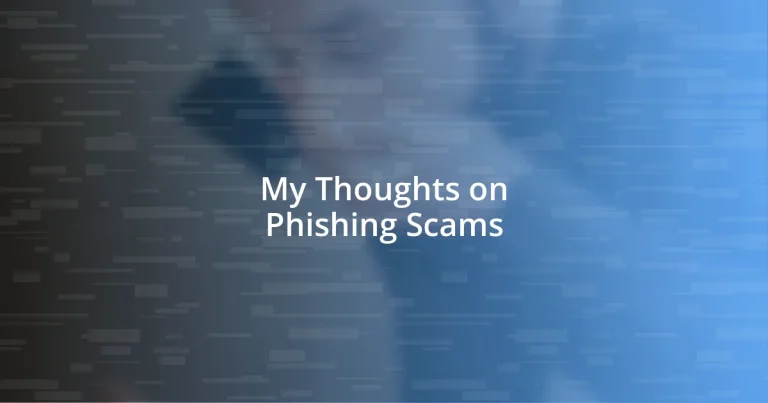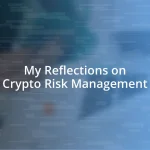Key takeaways:
- Phishing scams involve deceptive tactics to extract sensitive information, often leveraging urgency and personalized details to manipulate victims.
- Recognizing signs of phishing attempts, such as poor language, mismatched links, and unsolicited requests for personal information, is crucial for protection.
- Staying informed about phishing trends, employing strong password hygiene, and utilizing reporting platforms can significantly enhance online safety and help combat scams.
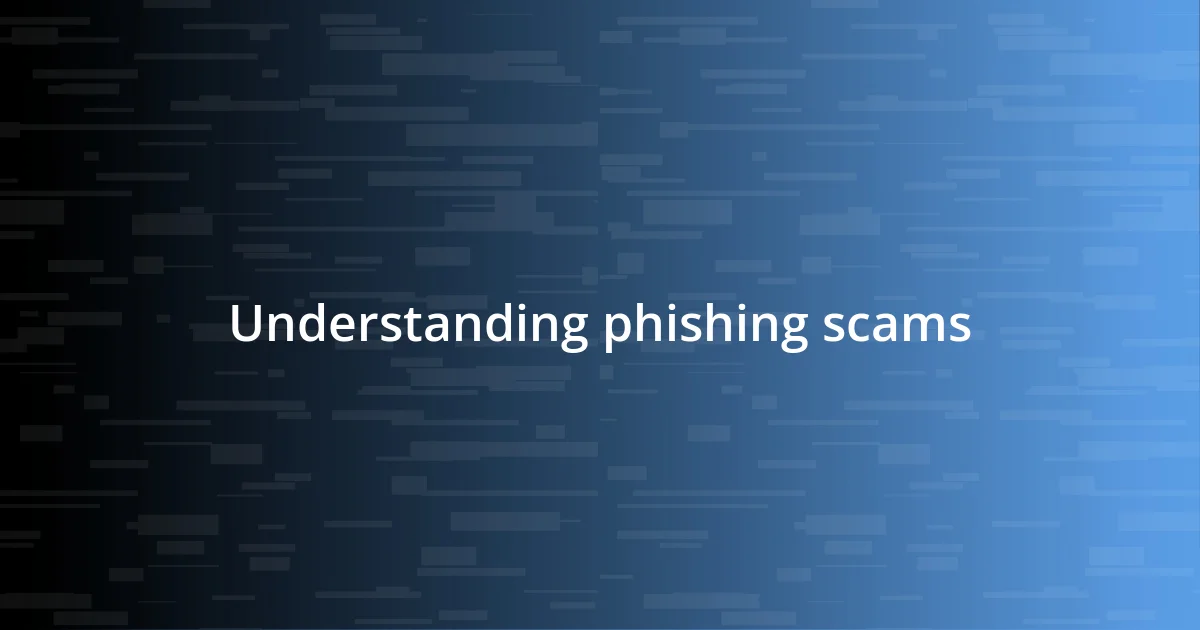
Understanding phishing scams
Phishing scams are deceptive attempts to trick individuals into revealing sensitive information, like passwords or credit card numbers, often masquerading as trustworthy entities. I still remember the unease I felt when I received an email that appeared to be from my bank, urging me to click a link to “verify” my account. It made me wonder how easily people can fall into such traps, especially when urgency is embedded in the message.
These scams can take many forms, including emails, text messages, or even phone calls that aim to create fear or excitement to prompt rash decisions. I’ve had friends share stories of their own close calls, feeling that momentary panic of potentially being hacked. It’s staggering how these scammers exploit our emotions; what do you think they gain from instilling fear in potential victims?
Another layer to understanding phishing scams is recognizing their sophistication. They’ve evolved past simple attempts and now often include personalized details about the target. I recall researching a case where an acquaintance was targeted through social media, and it struck me how the scammer had done their homework, making the experience all the more unsettling. Have you ever thought about how much personal information we share online that makes us vulnerable?
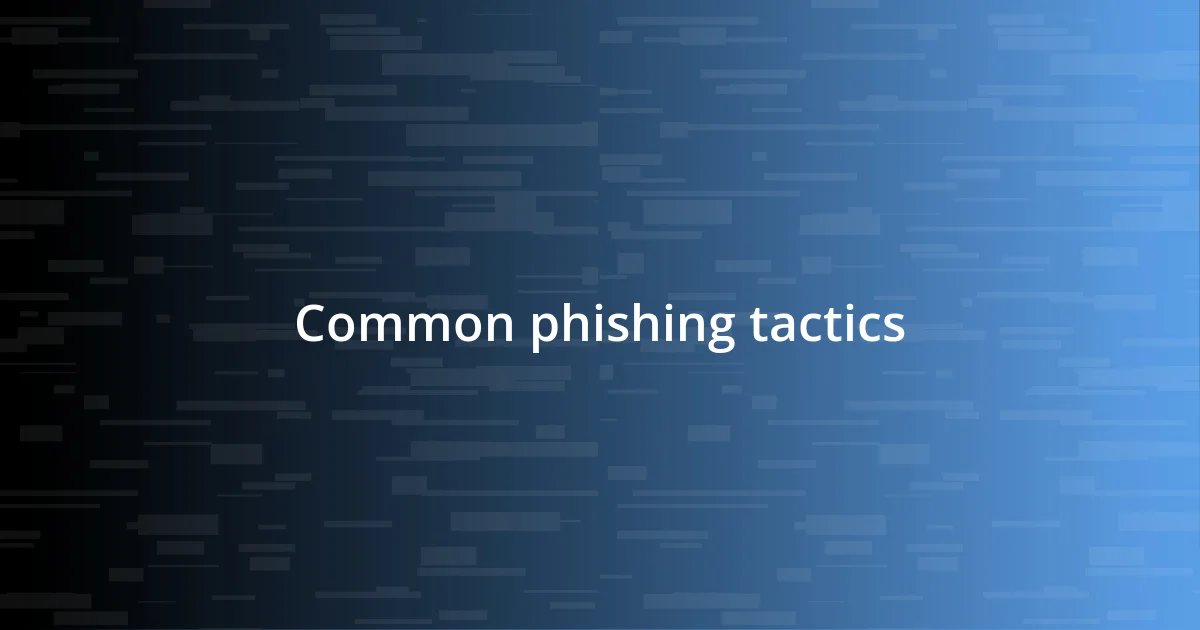
Common phishing tactics
Phishing tactics are crafty, and some of the most common ones manipulate our emotions directly. For instance, I once received a text claiming to be from a delivery service, stating my package was undeliverable and urging me to “resolve the issue” quickly. That rush to act, amplified by a sense of urgency, is a tactic scammers frequently use. It’s unsettling how they can exploit our daily routines so effectively.
Here are some common phishing tactics to watch out for:
- Urgent messages: Implying immediate action is needed, often to avoid negative consequences.
- Spoofed emails: Faking the sender’s address to appear legitimate, usually from banks or service providers.
- Unexpected attachments: Encouraging you to open files that can contain malware.
- Fake websites: Creating a clone of a legitimate site to capture your login details seamlessly.
- Personalization: Using your name or details from social media to make the scam more convincing.
I can’t help but feel a mixture of frustration and empathy for those who fall victim. It’s a reminder of how important it is to stay vigilant and informed in a digital world that can sometimes feel increasingly perilous.
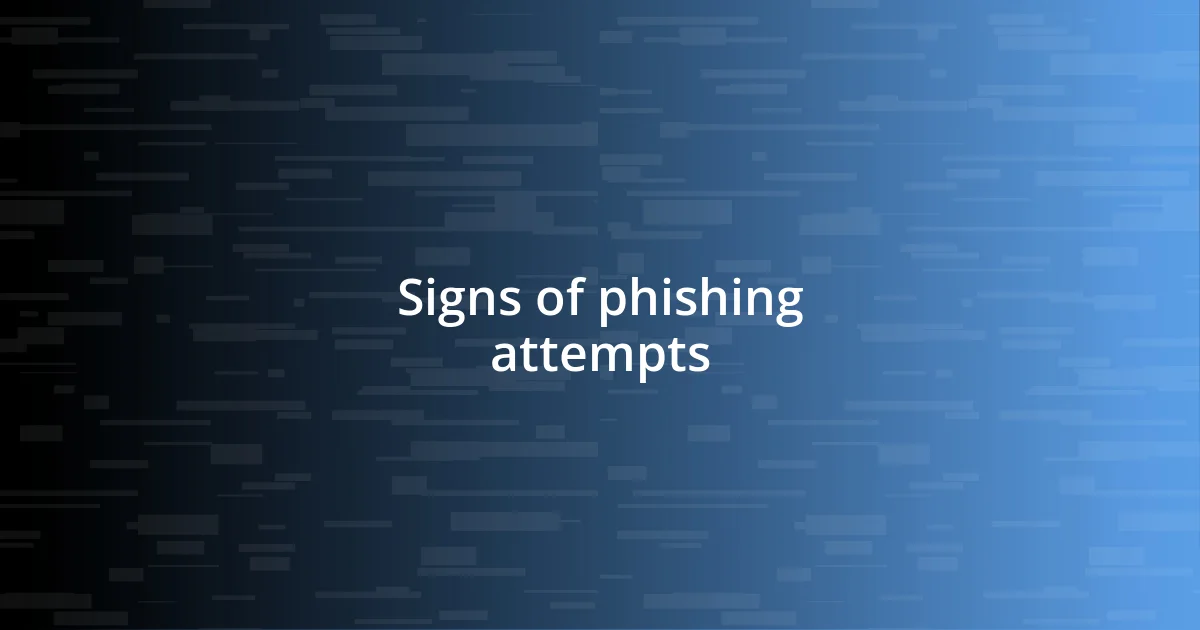
Signs of phishing attempts
When it comes to spotting phishing attempts, I find there are a few telltale signs that can really save you from a potential disaster. Often, the language used feels off, whether it’s poor grammar or odd phrasing. I once received an email that claimed to be from a tech support service, only to be immediately skeptical when I noticed the misspellings. It’s important to trust your gut when something just doesn’t sit right.
Another glaring red flag is the presence of links that don’t match the claimed URL. I remember clicking on a link in an email, only to notice the web address took me to a suspicious site. It was a shocking reminder of how quickly we can get tangled in someone else’s deceitful web. Being cautious with links is an essential habit to cultivate.
Lastly, if you ever receive unexpected requests for personal information, that’s a big warning. Scammers often pose as trusted organizations, making you feel secure just before they pull the rug out from under you. I’ve had experiences where I was asked for verification over the phone, but something didn’t feel right, and I chose to double-check with the company directly. That simple decision kept me safe from a sneaky scheme.
| Sign of Phishing Attempt | Description |
|---|---|
| Poor Language | Emails often contain grammatical errors or odd phrasing. |
| Mismatched Links | URLs that don’t align with the sender’s claim can indicate danger. |
| Unexpected Information Requests | Legitimate organizations rarely ask for personal info unsolicited. |
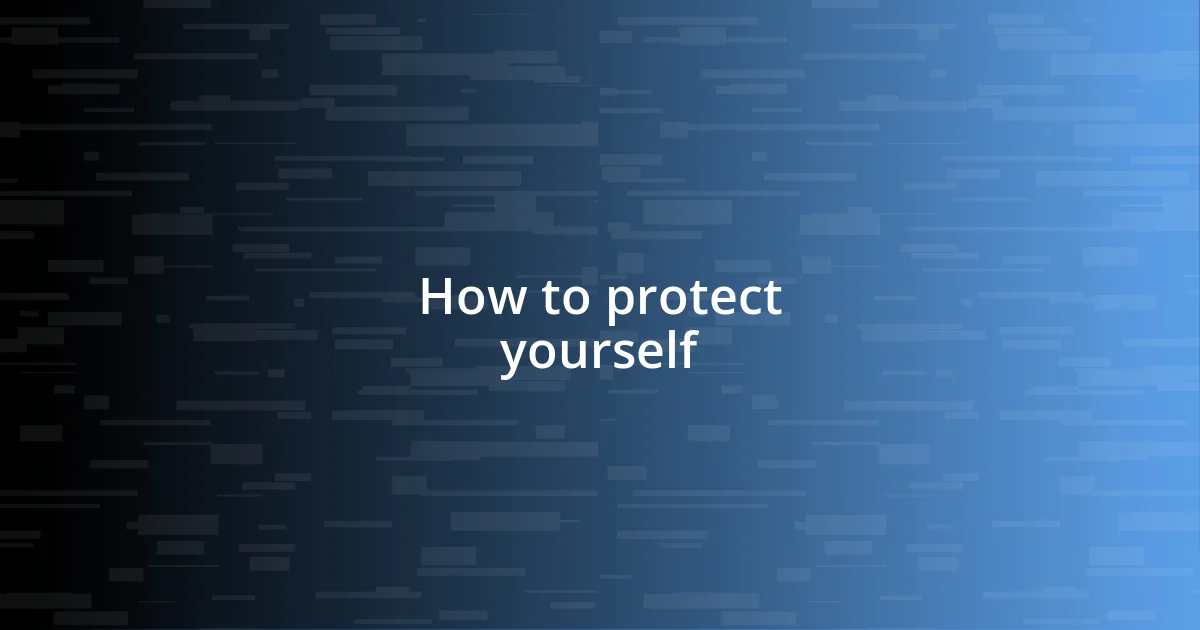
How to protect yourself
One of the most straightforward ways to protect yourself is to improve your password hygiene. I remember a time when I used the same password across multiple accounts—definitely a rookie mistake. It felt easy at first, but then I realized how vulnerable I was if just one site got compromised. Now, I make it a habit to use unique, complex passwords for each of my accounts, and I rely on a password manager. This tool not only generates strong passwords but also stores them securely, freeing me from the mental burden of remembering each one.
You also have to be cautious about your online interactions. Think about the last time a “trusted” contact sent you a link. Did you double-check it? I once received a suspicious link from a friend, and it turned out their account had been hacked. It’s alarming to consider how quickly someone can spiral into a scam. So, I always make it a point to verify unexpected messages—if it doesn’t feel right, I reach out to the person through another channel to confirm.
Moreover, being informed about the latest phishing trends can empower you. I make it a practice to keep up with news about cybersecurity, and I urge you to do the same. This knowledge not only helps me recognize potential threats but also equips me with the confidence to navigate the digital space more safely. Remember, awareness is your first line of defense. How often do you check for updates on scams? Making this a regular habit can be a game changer in your online safety strategy.
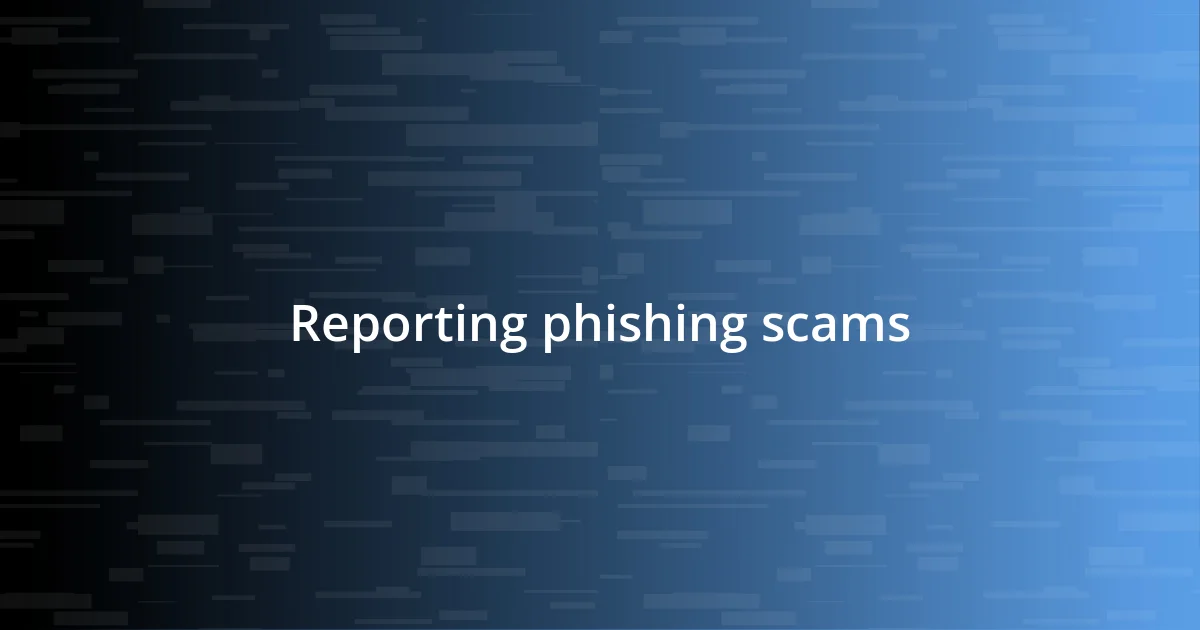
Reporting phishing scams
When it comes to reporting phishing scams, knowing where to direct your complaints is crucial. I still remember the sinking feeling I had after realizing the email I received was a scam. I immediately reported it through the email provider, which not only helped me but also could protect others. Don’t underestimate the importance of firing off a quick report.
Additionally, if you encounter a phishing attempt that impersonates a known organization, don’t hesitate to report it directly to the company involved. I once received a phishing email that pretended to be from a bank. After verifying the situation, I contacted the bank’s customer service and reported the email. Their response was reassuring; they were able to take steps to alert their customers. It felt good to know I played a part in potentially stopping others from falling into that trap.
Finally, I’ve come to realize the impact of utilizing reporting platforms, like the Federal Trade Commission (FTC) or local authorities. After facing a particularly nasty phishing attempt, I filed a report, and honestly, it felt empowering. It’s like taking a stand against digital deceit. Have you thought about joining the fight against scammers? Sharing your experience can help raise awareness and help protect someone else, and that’s something we can all feel good about.
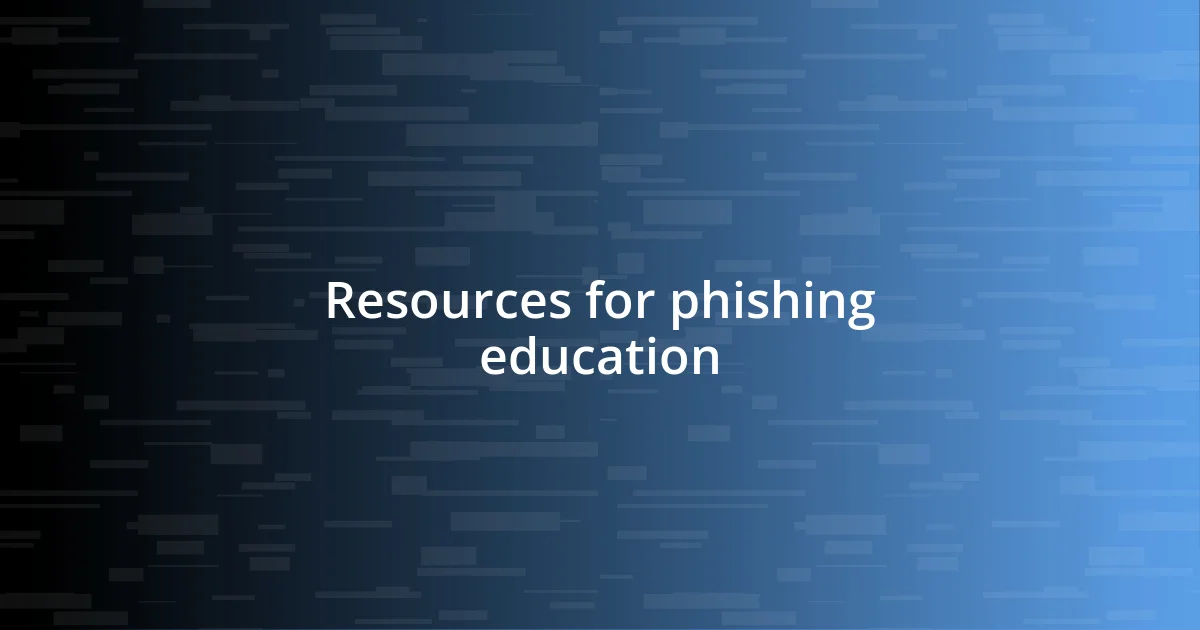
Resources for phishing education
It’s vital to stay educated about phishing scams, and I’ve found several resources that can really enhance your understanding. For starters, websites like the Anti-Phishing Working Group offer an array of articles and statistics that open your eyes to just how prevalent these scams are. I recall diving into their resources and realizing how insidious some of these tactics truly are—fly-by-night phishing sites can look strikingly legitimate! The awareness gained from this research was eye-opening.
Another excellent resource is the Federal Trade Commission (FTC), which provides comprehensive guides on recognizing and reporting phishing attempts. When I started exploring their tips and educational materials, it felt like a weight lifted off my shoulders—knowledge really is power. Have you ever found yourself uncertain about the authenticity of a message? The FTC’s ‘consumer alerts’ section gives you the confidence to discern the real from the fake.
Don’t forget about online courses! I took a course on cybersecurity basics, and it completely changed the way I view email and text communications. The course not only provided theoretical knowledge but also practical exercises that—I must admit—turned out to be quite enlightening. It’s fascinating how simulations of phishing scenarios can make the learning stick. Have you considered engaging in such a course? It might be a game changer in keeping you safe online.












